Introduction
The adoption of artificial intelligence (AI) is revolutionizing the insurance industry, with automated claims processing at the forefront of this transformation. By implementing intelligent document processing (IDP), insurance companies can extract essential information from unstructured data, increasing efficiency and accuracy. The demand for fast claims processing is a top priority for customers, emphasizing the urgency for insurers to enhance response times.
Generative AI supports various tasks, improving the customer experience and expediting the claims process. The auto insurance sector recognizes the need to adopt automation technologies to remain relevant. The stages of automated claims processing are meticulously designed to maximize efficiency and accuracy, from claim intake and data extraction to settlement and payment.
Implementing automation requires strategic planning, selecting the right technology, and embracing a culture open to change. Integrating AI and machine learning into claims processing systems is crucial for insurers to stay competitive and responsive to customer demands. Security and compliance considerations are paramount in the implementation of automated claims processing.
Best practices for successful automation implementation include a comprehensive assessment of data sources, balancing strategic initiatives with lean process automation, and investing in InsurTech solutions. The successful integration of automated claims processing relies on understanding the technology, strategic planning, and adapting processes to meet customer and industry needs.
Benefits of Automated Claims Processing
The adoption of artificial intelligence (AI) is transforming the coverage landscape, with automated claims processing at the heart of this change. By implementing intelligent document processing (IDP), entities in the insurance sector such as Commercial P& C Carriers, Reinsurance Carriers, and Life Insurance Carriers are harnessing the power of AI to extract pertinent details from unstructured information, propelling efficiency and accuracy to new heights. With approximately 85% of insurance enterprise data being unstructured, the ability to manage this data rapidly and reliably is no longer a choice but a necessity to maintain a competitive edge.
AI-driven claims automation not only fulfills user expectations for prompt handling of insurance requests but also addresses insurers’ operational requirements. A survey by Sollers Consulting and Ipsos suggests that efficient processing of insurance requests is a primary concern for 52% to 63% of customers in different countries, emphasizing the need for insurers to improve their response times. As reported by Kassandra Jimenez-Sanchez, the demand for rapid claims resolution is most pronounced in the UK at 63%, signaling a clear directive for insurers to accelerate their digital transformation efforts.
The impact of generative AI on the insurance industry is evident. It supports a variety of tasks, from searching and summarizing information to extracting key insights, thereby enhancing the experience during critical touchpoints such as the First Notice of Loss intake. This not only expedites the claims process but also ensures a more seamless interaction for the customer.
In the face of rising costs and shifting consumer behaviors, the auto coverage sector acknowledges the imperative to adopt automation technologies to remain relevant. As Bill Brower notes, the time for action is now; embracing automation is essential for future-proofing and staying ahead in an increasingly tech-driven environment. With the majority of financial services and leaders in the insurance sector acknowledging the initiation of AI proofs of concept, yet only 36% employing them extensively across business functions, the journey towards full AI integration continues. This continuous development ensures to redefine the insurance industry, delivering unmatched efficiency and satisfaction.
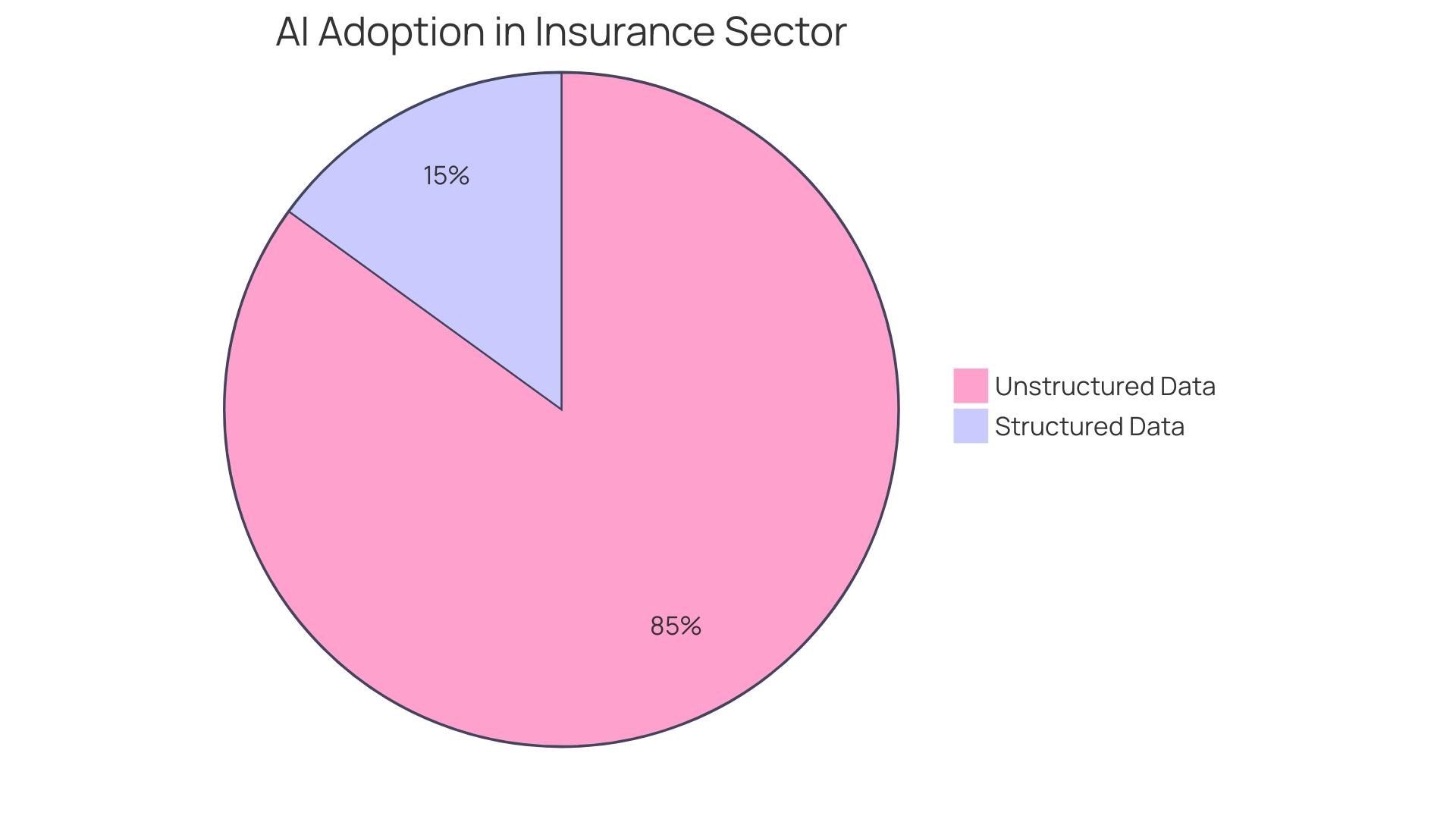
Key Technologies in Automated Claims Processing
Insurance companies are adopting advanced technologies to enhance the efficiency of processing claims, which is a fundamental aspect of ensuring client satisfaction. Generative Artificial Intelligence (Gen AI) is transforming the way insurers manage claims by automating the assessment of policy coverage, expediting the First Notice of Loss, and enhancing the extraction of insights from information. This technology helps in identifying missing information, summarizing key points, and clarifying areas that require attention, thereby enhancing the customer experience.
Moreover, Intelligent Document Processing (IDP) has emerged as a transformative tool, especially in managing the overwhelming amount of unstructured data within the industry. This technology provides insurers with the capability to quickly retrieve and handle information from documents, which are vital for efficient management of insurance requests. The shift to digital channels has reinforced the need for such tools that balance speed and accuracy in the underwriting process, ultimately leading to improved operational efficiency.
The importance of embracing these technologies is emphasized by recent discoveries from Sollers Consulting and Ipsos, which show that a prompt reimbursement procedure is a leading anticipation among clients. This is particularly true in regions like the UK, where rapid claims handling is a critical factor for customer satisfaction, even more so than the compensation amount.
To capitalize on these advancements, insurers are actively pursuing AI proofs of concept, with a significant number already witnessing tangible benefits. However, the journey to widespread adoption is not without challenges. Despite the optimism, only a fraction of leaders report extensive application of AI across their business functions, indicating that many are still exploring how to fully leverage AI’s potential.
The commitment to technological enhancement in the sector of risk coverage is evident in the words of industry leaders, emphasizing the importance of a fail-fast approach and the continuous evolution of digital capabilities to improve the experience of processing. As the industry progresses, it is becoming increasingly clear that insurers must decide whether to lead or follow in this digital transformation.
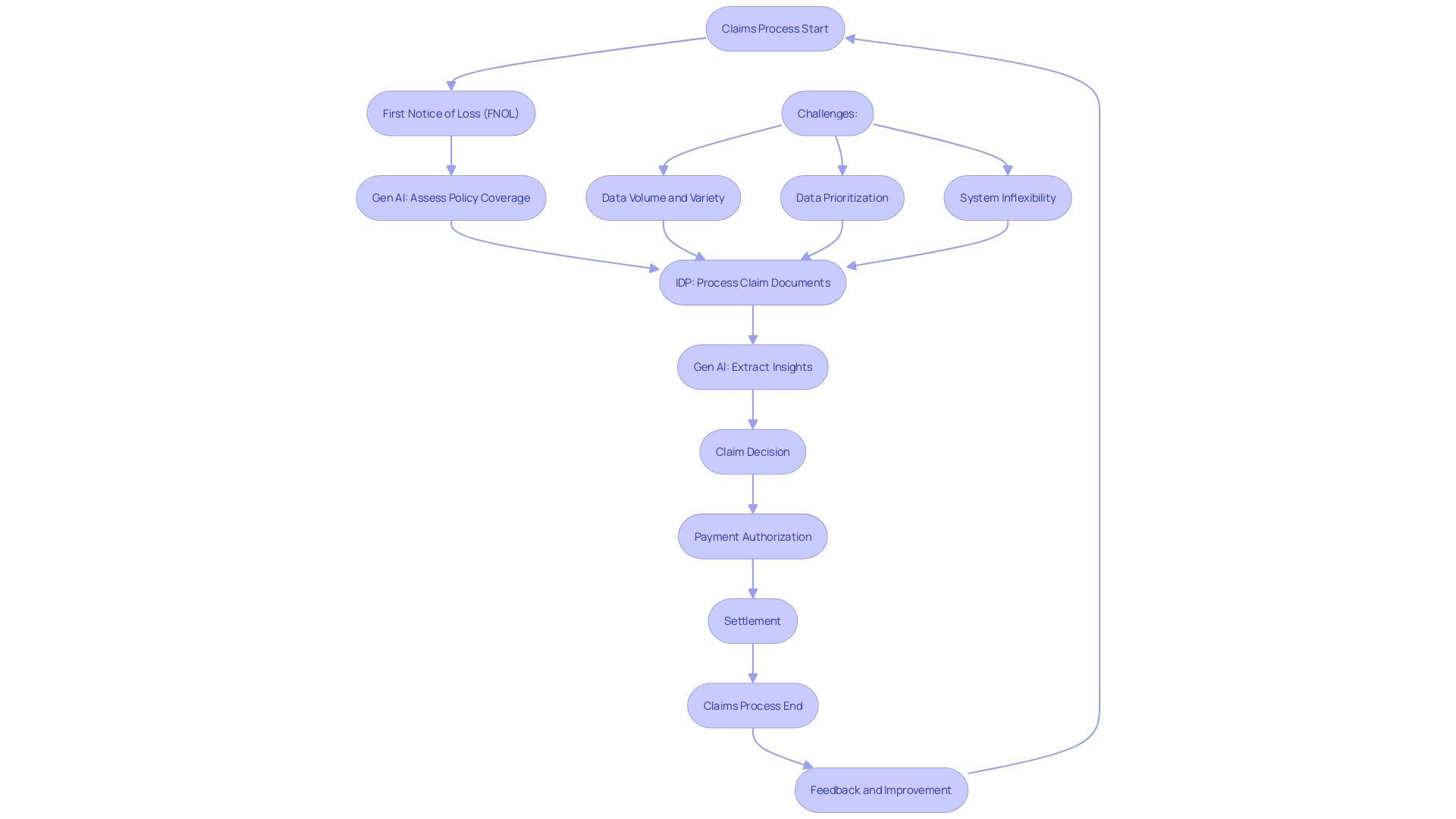
Stages of Automated Claims Processing
The evolution of automated claims processing has been a game-changer in the insurance industry, transforming the way disputes are managed from initial intake through to settlement. At the heart of this innovation is the deployment of Generative Artificial Intelligence (GenAI), which has empowered providers to streamline complex tasks, including the creation and management of medical visit notes. For instance, pediatric care provider Summer Health has leveraged AI to simplify the traditionally time-consuming process of translating medical shorthand into comprehensive summaries, thereby reducing the administrative burden on physicians and enhancing the clarity of communication for parents.
As we break down the stages of automated claims processing, it’s evident that these are meticulously designed to create a seamless workflow. Starting with the First Notice of Loss, AI assists in evaluating policy coverage and identifying any gaps in claim data. It summarizes key points and clarifies areas that require attention, thereby enriching the client experience in an era where expectations are soaring and costs are mounting.
Moreover, the technology is pivotal in denial management. When insurers refuse to reimburse providers based on the patient’s coverage, AI steps in, allowing for the meticulous review and resolution of denials. This not only addresses the immediate issue but also aids in formulating preventive measures to forestall future denials. Such strategic approaches are enhanced by AI-driven software, which automates the tracking and appeals process, a technique that has proven to be highly effective.
The impact of GenAI is not limited to customer interactions. It also provides a backbone for accurate financial reporting, crucial for both internal analysis and regulatory compliance. A poorly conceived Record to Report (R2R) process can lead to unreliable financial statements, undermining the trust of stakeholders. However, AI ensures a robust R2R process, safeguarding the organization’s reputation and financial integrity.
Statistics underscore the potential of AI in healthcare, with large language models (LLMs) offering solutions for everything from clinical decision support to the reduction of administrative costs, which are notably higher in the U.S. healthcare system compared to other countries. The sector of coverage, specifically property and casualty, has been an early adopter of this technology, with studies showing that although 91% of financial service and insurance leaders have initiated AI projects, a mere 36% have integrated these tools across various business functions. Nevertheless, the quest to harness Ai’s full potential continues, with 70% of companies actively exploring ways to capitalize on its benefits.
In conclusion, the automated processing of requests journey is characterized by a sequence of stages, each designed to optimize efficiency and accuracy. Through the strategic application of GenAI, the industry is not only reshaping its internal processes but also delivering a level of service that meets the modern-day expectations of both providers and clients.
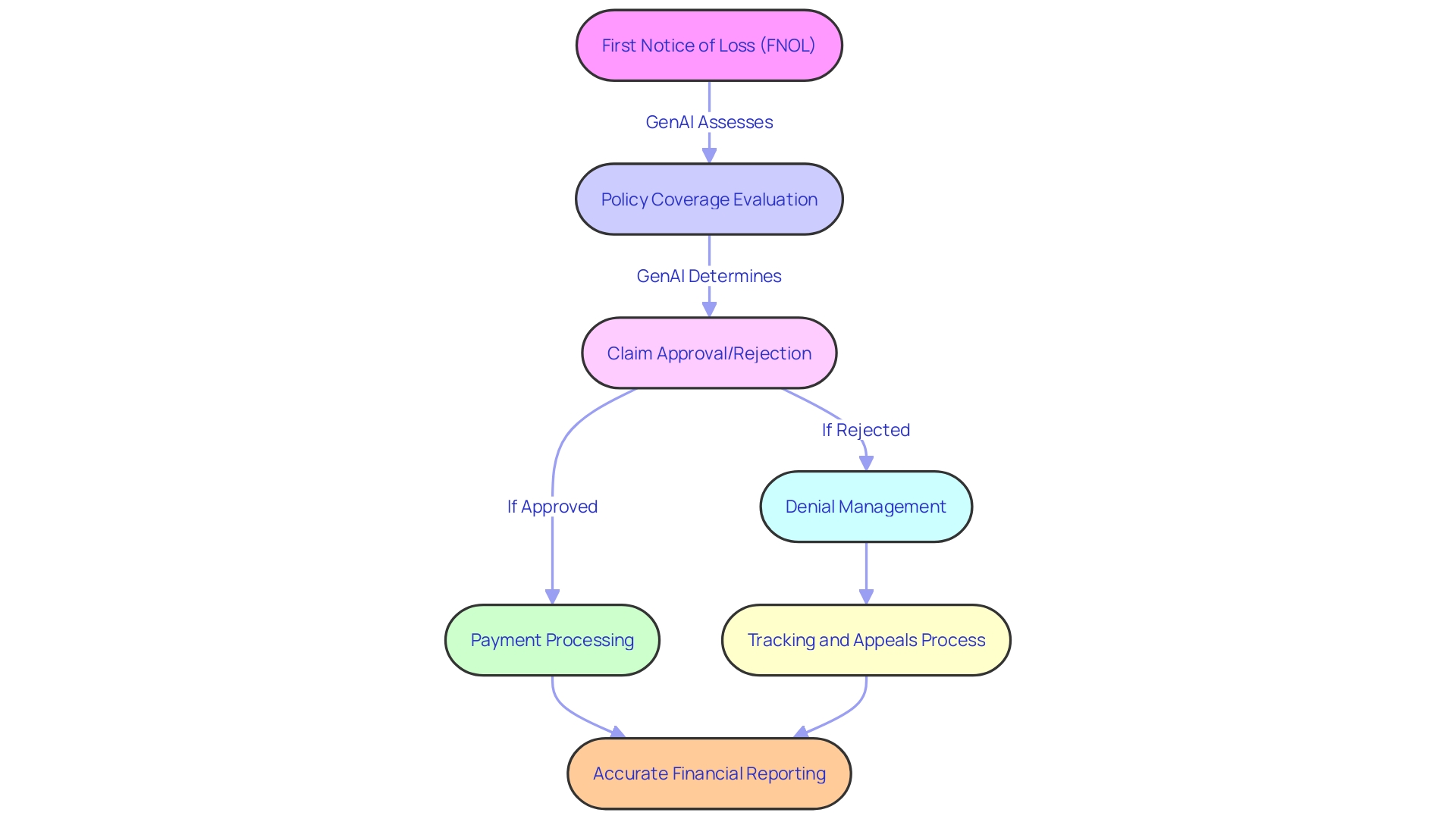
Step 1: Claim Intake and Data Extraction
Beginning the process of automated processing for insurance claims starts with the crucial task of information intake and extraction. This crucial first step is all about gathering the claim details from a plethora of sources, which may range from structured legacy information such as tables containing claims information and billing details, to more modern formats like JSON files that hold policy and product details. The technology that’s truly transforming this stage is Intelligent Document Processing (IDP), which excels in handling the vast majority of information that tends to be unstructured—think emails, forms, and incident reports.
IDP doesn’t simply gather information; it identifies and extracts the valuable nuggets of knowledge that are often concealed within the text. For example, it carefully identifies policyholder information, intricacies of the incident in question, and any relevant documentation required for further processing. The power of IDP is evident in its ability to provide swift access to data while maintaining high accuracy standards, a balance that has been historically challenging to strike in the insurance sector.
This technology, driven by advancements in artificial intelligence such as large language models (LLMs), has proven its worth by offering a variety of enhancements to the process of asserting ownership. LLMs are particularly adept at generating, classifying, and summarizing information, which can elevate the customer experience by streamlining the initial notice of loss intake and ensuring that all relevant information is captured and highlighted for further action. The utilization of these AI-driven solutions is becoming increasingly widespread, as they guarantee not only to expedite the process of claims but also to enhance it, offering a competitive edge in an industry where timely and accurate information analysis is paramount.
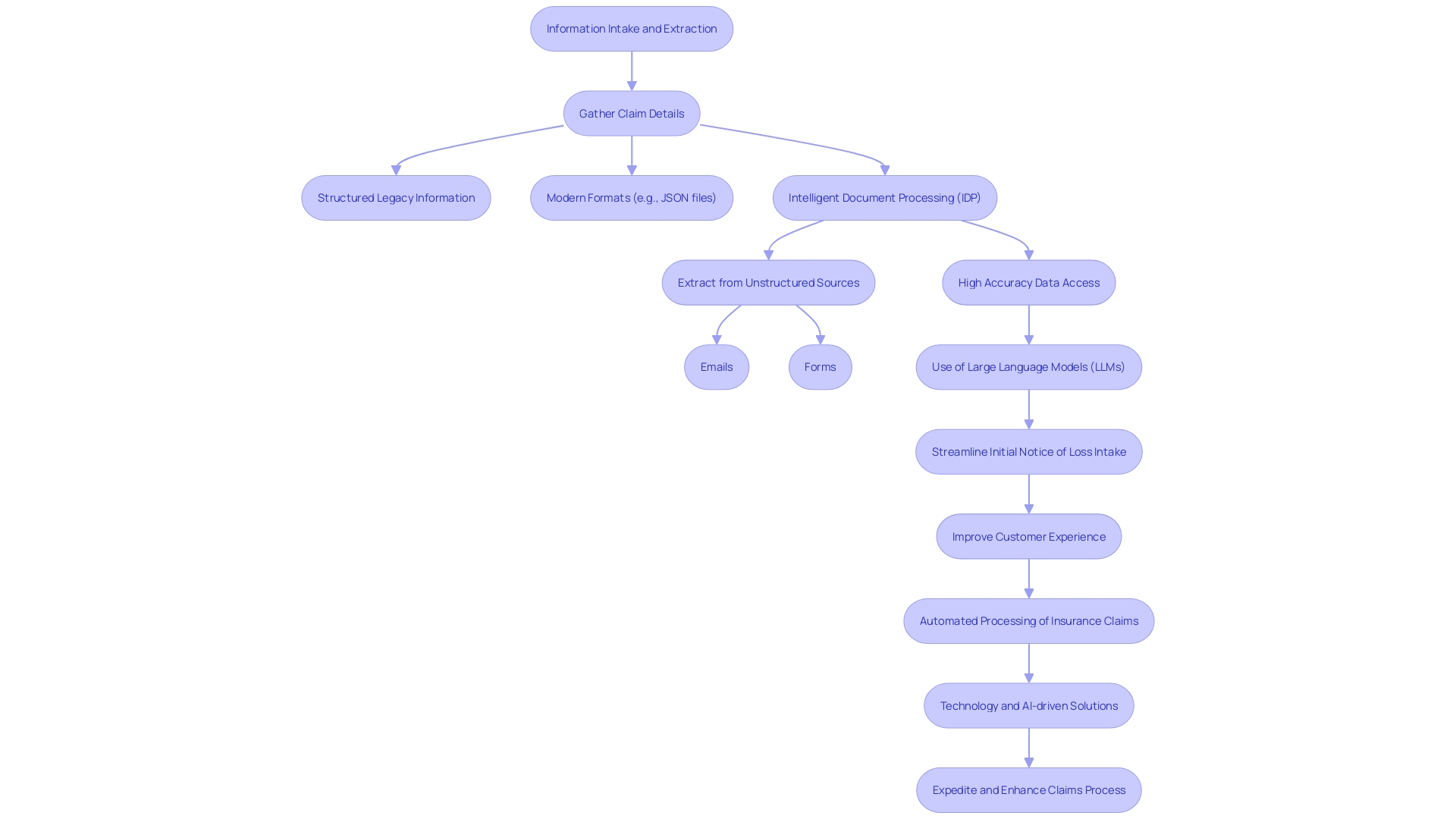
Step 2: Claim Validation and Verification
By incorporating advanced AI algorithms, the process of insurance claims is transformed into a more efficient and secure operation. After extracting data, it’s crucial to validate and authenticate the information meticulously. In this crucial phase, there is a comprehensive evaluation of the existing policy particulars, prior records, and a variety of pertinent databases to guarantee absolute precision. The advanced AI technology explores patterns in claims, revealing any irregularities that could indicate potential fraudulent activity, thereby protecting the integrity of the process. Moreover, the integration of visual information, like pictures of events such as fires, aids adjusters in precisely evaluating harm and validating assertions, which simplifies the process of making decisions. This modern approach to insurance claims processing not only accelerates the underwriting and handling but also enhances consumer protection and satisfaction by providing a more personalized experience. As the industry continues to evolve, the adoption of AI and data analytics stands as a testament to the sector’s commitment to innovation and excellence in client service.
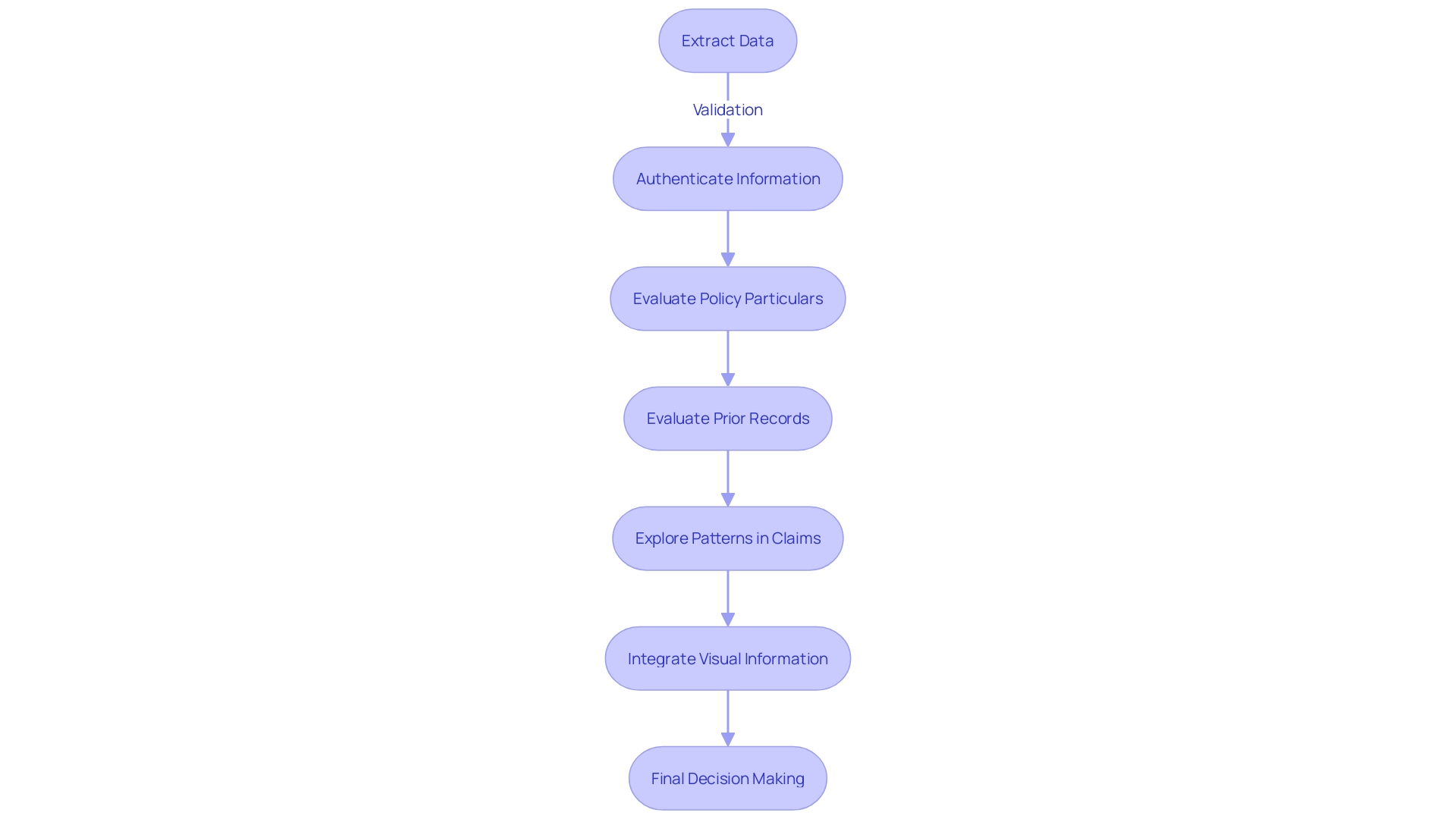
Step 3: Claim Investigation and Evaluation
As the landscape of insurance processing evolves, artificial intelligence (AI) is playing a pivotal role in revolutionizing this domain. Throughout the investigation and evaluation phase of a case, AI is not only a means for efficiency but a revolutionary power, reshaping the approach insurers adopt toward claims handling. By leveraging Ai’s capacity to meticulously analyze claim details and assess the extent of damage or loss, the technology is ensuring a more accurate and swift validation of claims. Ai’s capability extends beyond mere analysis; it is adept at collecting and synthesizing additional data, whether it’s accident reports or medical records, to bolster the evaluation process. This use of AI is in line with the broader industry trend where, despite some skepticism, companies are witnessing tangible benefits from AI adoption. With a significant percentage of financial services and insurance leaders confirming the launch of AI proofs of concept, the industry is increasingly recognizing the value of AI in enhancing operational efficiency and combating fraud. This shift is evident as insurers seek to transition from traditional, labor-intensive evaluation of insurance requests to more sophisticated, automated systems. By doing so, they are not only streamlining processes but are also aligning with regulatory frameworks that mandate the proper use of AI, avoiding unfair practices and ensuring the protection of consumer data. The dedication to integrating AI in the processing of insurance requests reflects the general acceptance of technology in the industry for enhanced customer satisfaction and operational efficiency.
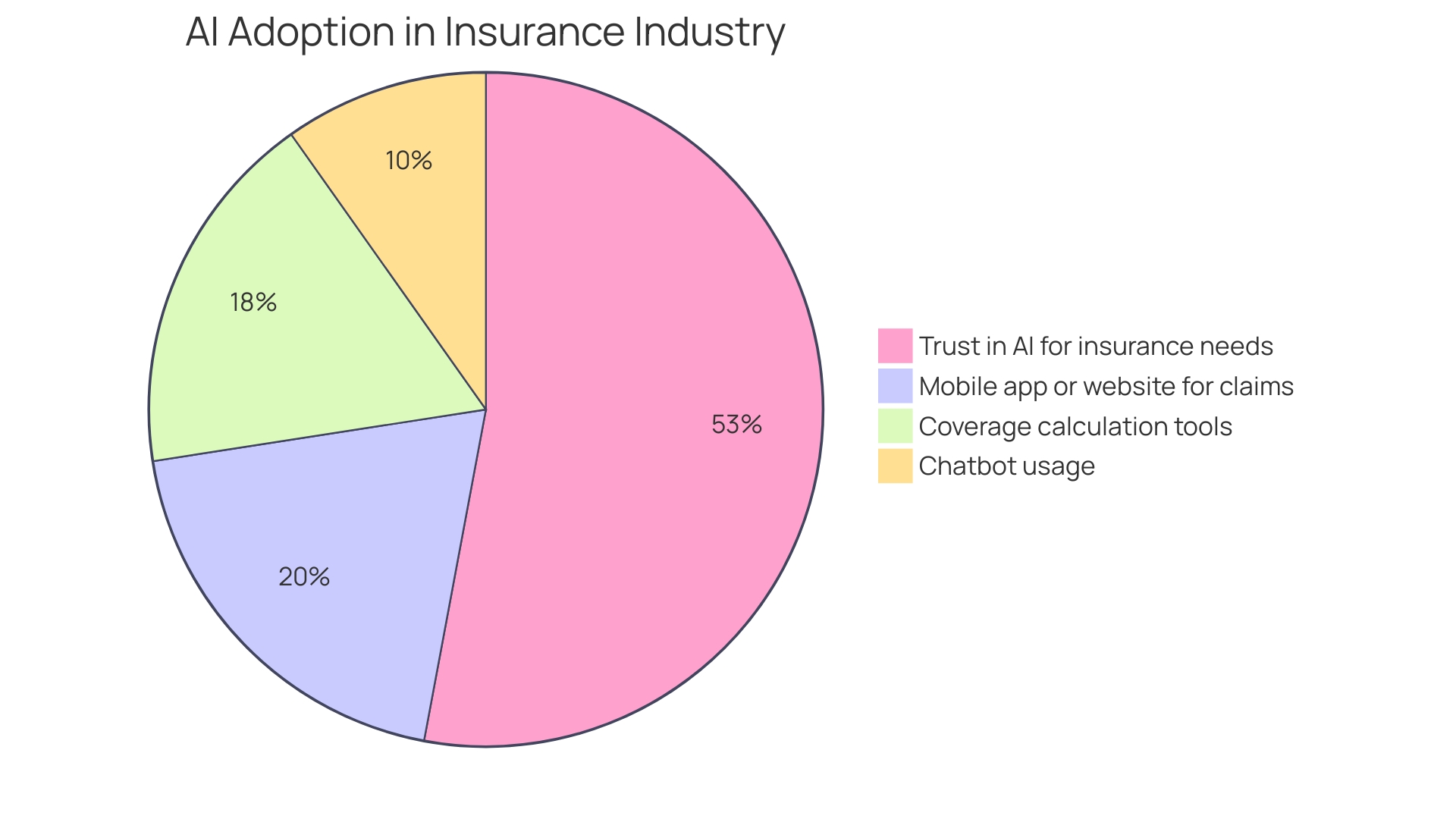
Step 4: Claim Settlement and Payment
The arrival of generative artificial intelligence (GenAI) has ushered in a transformative era in various industries, and the sector of coverage is no exception. As the settlement and payment stage of coverage cases becomes more complex, AI-driven systems are capable of determining suitable settlement amounts with remarkable accuracy. These systems are programmed with an intricate understanding of policies and regulations, ensuring that the offers generated align with the predefined criteria.
A testament to the efficiency of AI applications is the fact that property/casualty insurers, early adopters of GenAI, are witnessing tangible benefits from its implementation. Despite the initial skepticism surrounding AI, these insurers are now leveraging automated systems that not only generate settlement offers but also execute payment transactions seamlessly, providing policyholders with prompt and transparent updates.
This movement towards AI-powered management of insurance cases reflects a wider pattern within the financial services and insurance sectors. While 91% of leaders in these sectors have kicked off AI initiatives, only 36% have implemented them extensively across various business functions. Still, the push towards AI is undeniable, as 70% of companies remain intent on unlocking Ai’s advantages, a journey marked by strategic deployment and adherence to regulatory guidelines like those issued by New York’s Department of Financial Services.
The process of incorporating AI into the handling of insurance requests is a intricate one, requiring a transparent moral structure and a readiness to adopt a ‘fail-fast’ method for ongoing enhancement. As insurers navigate this path, they are setting a precedent for operational excellence, driven by a commitment to improving client experiences and streamlining internal processes.
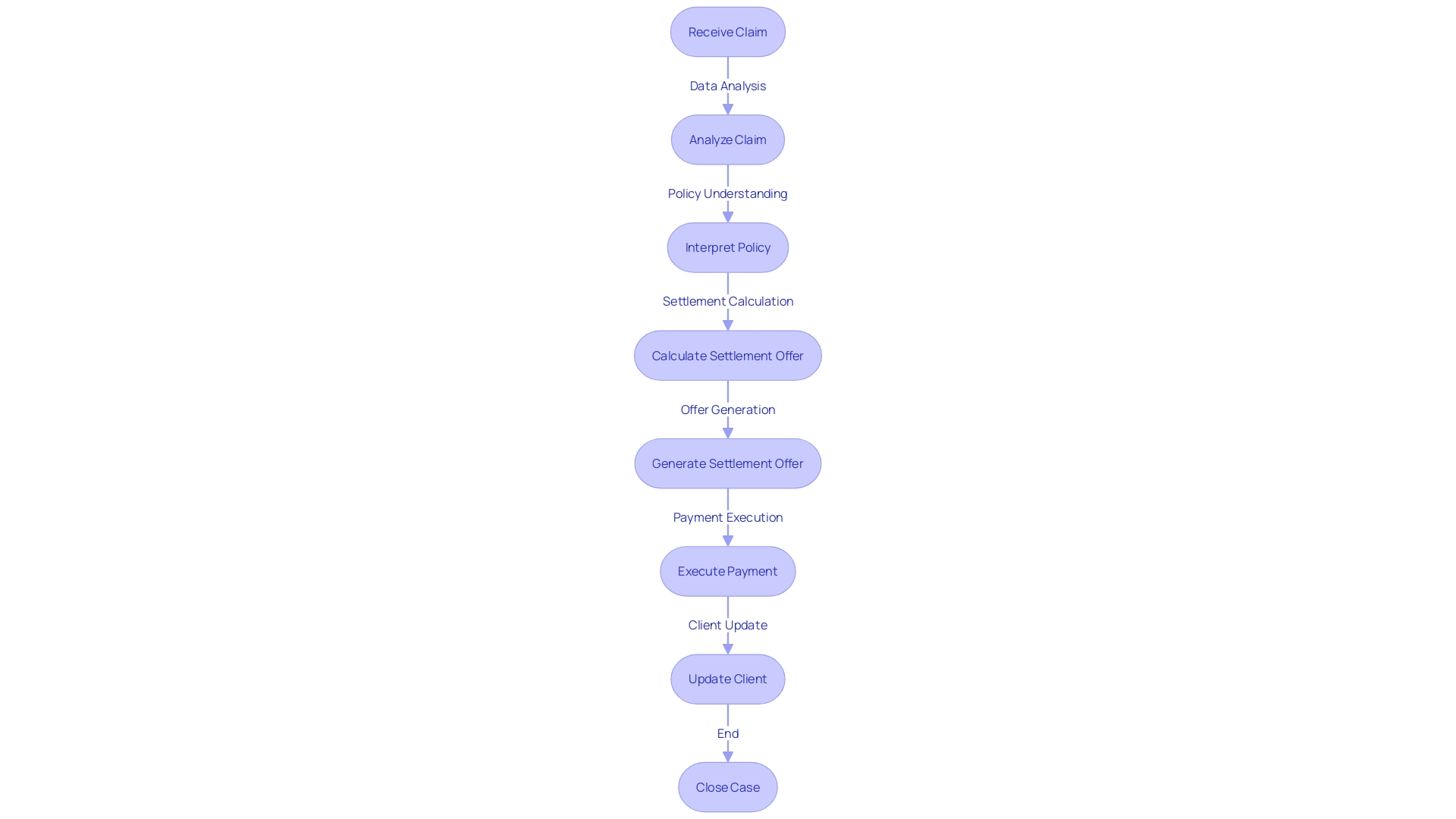
Implementing Automation in Claims Processing
Implementing automation in the domain of processing claims not only streamlines operations but also significantly enhances client satisfaction. The integration of artificial intelligence (AI) and machine learning (ML) into management of insurance cases is transforming how insurers interact with customers and handle their internal processes. For instance, think about the situation where an insurance company uses a single email address to gather requests. Before, a manual assessment was required to direct each request to the suitable department, which was not just time-consuming but also susceptible to mistakes. To address this, Frende Forsikring leveraged AI to automatically direct claims to the relevant management unit, achieving remarkable accuracy and efficiency.
Furthermore, the sector for coverage is ready for a dynamic shift as an estimated 50% of its workforce approaches retirement by 2028. This opens doors for a new generation of professionals who can bring fresh perspectives, especially in the utilization of contact center and technology capabilities that are critical for strategic growth, cost management, and compliance.
As for the implementation of such automation, it’s instructive to recognize that the underwriting process, traditionally known for its meticulous nature, is being transformed by automation to increase productivity and reduce error rates. Gen AI, specifically, acts as a potent tool for companies in the insurance sector, enhancing the experience of clients during the First Notification of Loss intake by improving policy coverage evaluations and streamlining data processing.
Industry leaders, like Lee Elliston from the Aspen Group, highlight the significance of digital capabilities throughout the claims ecosystem to meet policy promises and keep satisfaction levels high. Meanwhile, studies reveal that while 91% of financial services and insurance leaders have initiated AI projects, only 36% have implemented them broadly, indicating a significant opportunity for wider application to harness AI’s full potential.
In practice, companies like Alm. Brand Group are partnering with firms like Cognizant to automate manual and repetitive processes, thereby boosting efficiency and competitive edge. Such strategic collaborations are vital as they provide a clearer vision and ethical framework for AI use, ensuring that digital tools are leveraged transparently and effectively for the benefit of individuals and employees alike.
To summarize, the effective implementation of processing automation relies on strategic planning, choosing the appropriate technology, and embracing a culture that is open to change. With the correct approach, companies can not only improve operational efficiency but also enhance the customer experience, ensuring that they are well-positioned for the future of the industry.
Essential Integrations for Automated Claims Processing
The domain of handling insurance claims is being revolutionized by artificial intelligence (AI) and machine learning (ML), offering unparalleled efficiency in processing and managing claims. For example, the Norwegian company Frende Forsikring optimized its email-based reporting of claims by utilizing AI to accurately direct claims to the relevant management unit, eliminating the necessity for laborious manual sorting. Incorporating such intelligent systems requires careful planning, particularly when considering the projected workforce changes with a substantial portion set to retire by 2028, opening opportunities for fresh talent in the industry.
AI’s role in claims processing extends to improving client satisfaction by expediting claims management, a point emphasized by Swiss Re, a global leader in reinsurance and risk management. Their approach to embracing innovative technologies is a testament to the industry’s shift towards more resilient and forward-thinking operations.
Furthermore, the sector’s move to digital, automated procedures represents a notable change towards operational effectiveness and enhanced client encounters. Automation empowers insurers to meet the rising expectations for accessible, customer-focused services. This shift is not just a technological upgrade but a broader change in how insurance companies align with client needs.
To fully utilize the potential of automated processing of insurance requests, insurers must take into account their data processing needs, whether they are managing structured or unstructured data, and the amount and frequency of such data. Focusing on documents that usually necessitate extensive manual processing, such as invoices and forms, for automation can result in significant gains in efficiency and cost savings.
As the sector keeps progressing, the incorporation of AI and ML into processing systems for insurance demands is not just an improvement but a crucial element for insurers to stay competitive and responsive to the needs of their clients. The insights from industry thought leaders and case studies underscore the importance of adopting and integrating these technologies to streamline workflows, improve accuracy, and deliver a superior experience.
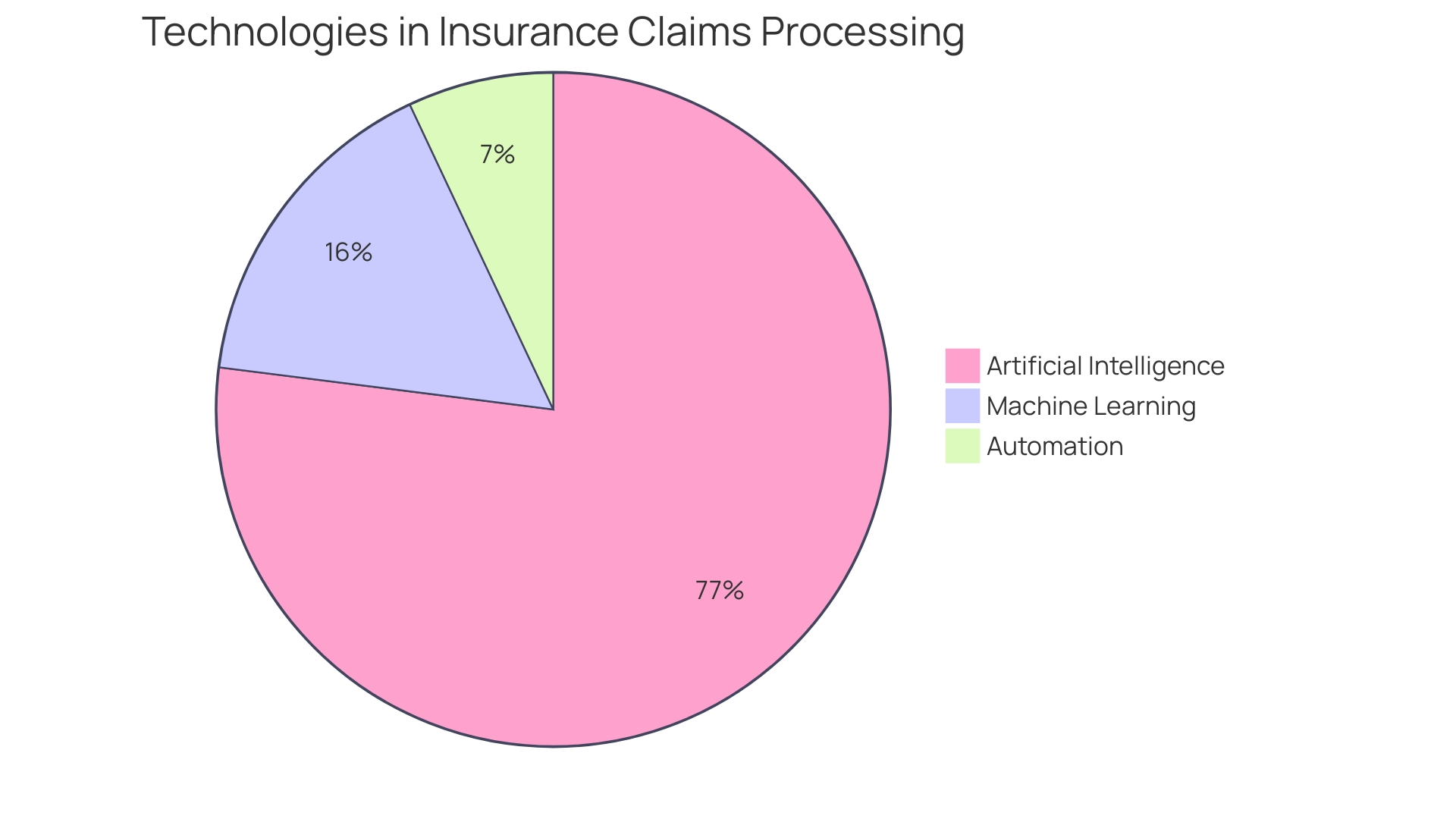
Security and Compliance Considerations
As the insurance industry evolves towards a more digital future, the implementation of automated claims processing has become a pivotal development, particularly in enhancing the efficiency and speed of the underwriting process. However, this innovation brings with it the critical need to address security and compliance issues head-on. Insurance companies are now focusing on safeguarding sensitive customer information and adhering strictly to industry regulations to maintain trust and integrity in their operations.
A thorough risk evaluation is crucial, assessing potential dangers to an organization’s systems and the information they manage. This assessment helps to understand the possible impacts of cyber incidents and to implement effective mitigation strategies. Data protection is a cornerstone of security measures, involving robust encryption and strict access control mechanisms to shield sensitive information both at rest and during transmission.
In the current landscape, where technology such as generative AI is being adopted at varying rates by traditional carriers and insurtechs alike, the industry is witnessing a shift that emphasizes the importance of transparency and ethical use of digital tools. The New York Department of Financial Services is one of the entities leading the charge by issuing guidance on AI usage, ensuring that consumer data and information systems are not misused.
With an eye towards the future, companies providing coverage are also preparing for a workforce transformation, as a significant portion is expected to retire by 2028. This offers an opportunity for the industry to attract new talent who are adept at working with advanced technologies and who can contribute to the evolving landscape of insurance services.
In line with these developments, entities must also be mindful of their obligations under regulations such as the Australian Privacy Principle 11.2, which mandates reasonable steps to destroy or de-identify personal information unless certain conditions are met. Regular reviews of information retention policies are recommended to ensure compliance and the protection of personal information.
The Arab National Bank’s digital transformation journey and the migration of information models using MongoDB Relational Migrator are examples of the strategic initiatives in play. These examples not only demonstrate a dedication to modernization and efficiency but also emphasize the requirement for a coordinated approach to information handling that aligns with lean process automation.
In general, the shift towards automated processing of claims in the insurance sector is a sign of progress, but it must be balanced with a strong commitment to security and compliance to ensure the protection of client data and adherence to ethical standards.
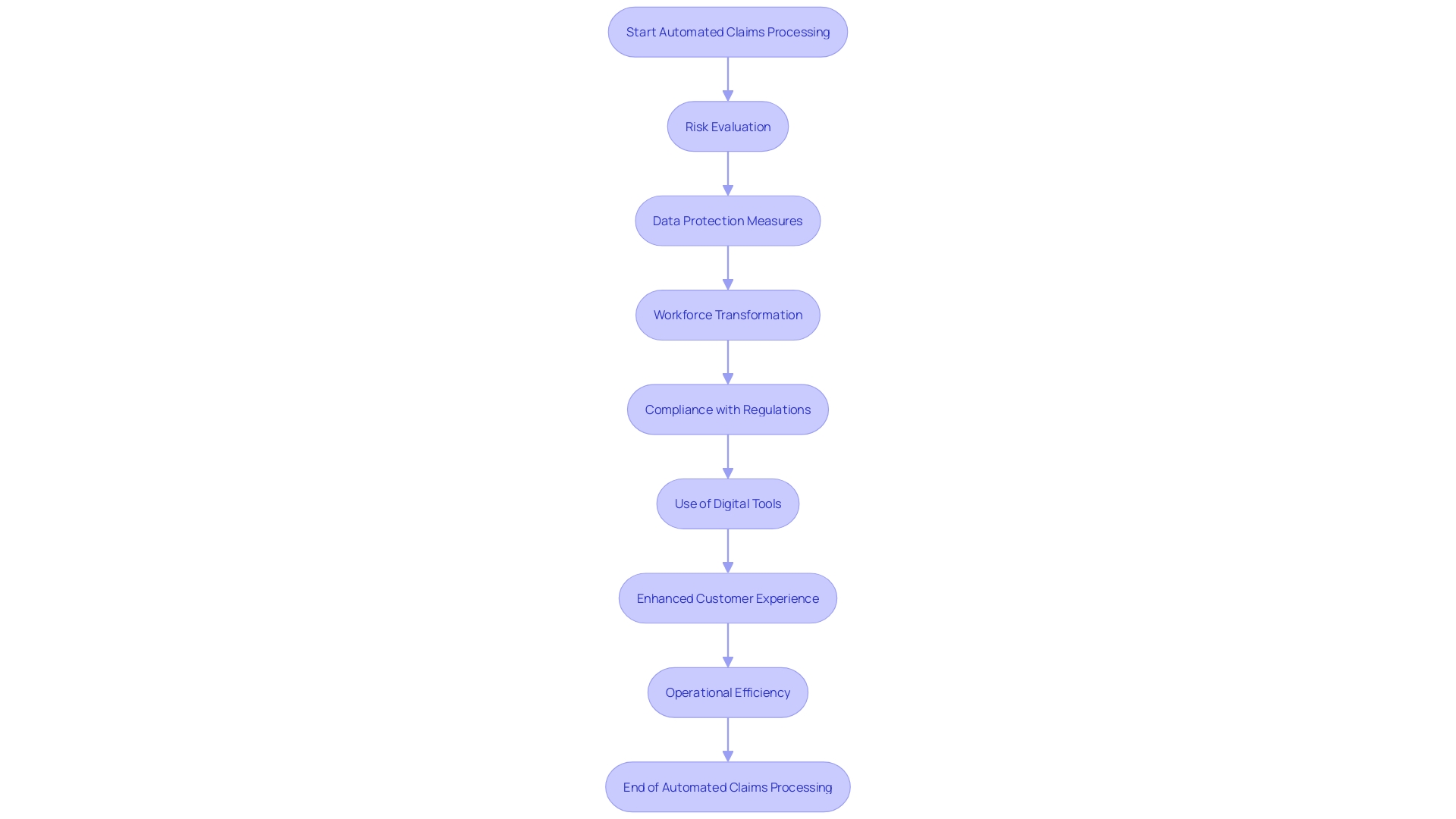
Best Practices for Successful Automation Implementation
As the sector for insuring policies develops with the incorporation of cutting-edge technologies, the implementation of automated processing of reimbursement requests has become crucial. By embracing generative artificial intelligence (GenAI), insurance companies can streamline the management of insurance requests, enhance customer experience, and achieve better operational efficiency. The technology’s ability to search, generate, classify, cluster, and summarize information is transforming the traditional workflow. For example, using GenAI, companies have improved the First Notice of Loss intake by assessing policy coverage and identifying key information, a shift that is both customer-centric and cost-effective.
An example is the Norwegian insurer, Frende Forsikring, which has effectively optimized the distribution of insurance requests to the appropriate management unit by utilizing AI. They consolidated their reporting of requests into a single email address, redirecting each inquiry to the appropriate unit with enhanced accuracy, reducing manual labor and improving processing times.
To ensure the seamless transition to automated processes, insurance companies should consider the following best practices:
-
Begin with a Comprehensive Assessment of Data Sources: Examine your structured legacy data and structured data in JSON format, ensuring that they are accurately categorized and prepared for migration to more flexible databases. A well-executed migration plan, like the one that refactored 21 relational tables to five MongoDB collections, is essential.
-
Balance Strategic Initiatives with Lean Process Automation: Implement solutions that not only foster automation but also provide a holistic view through service orchestration. This approach is critical as the industry prepares for a workforce transition, with many seasoned professionals retiring and new generations stepping in.
-
Invest in InsurTech Solutions: Specialized administration software for insurance, equipped with digital signatures, document management tools, and collaborative features, can autonomously manage routine tasks, enhancing efficiency.
Recent collaborations, such as Cognizant’s partnership with Alm. Brand Group, underscore the industry’s move towards automating traditional manual and repetitive tasks to enhance user experience and operational competitiveness.
Ultimately, the successful implementation of automated claims processing hinges on a clear understanding of the technology’s capabilities, the strategic planning of its deployment, and the continual adaptation of processes to align with evolving customer and industry needs.
Conclusion
In conclusion, automated claims processing powered by AI is transforming the insurance industry. By implementing intelligent document processing and generative AI, insurers can extract crucial information from unstructured data, enhancing efficiency and accuracy.
To successfully integrate automation, strategic planning, technology selection, and a culture open to change are essential. Insurers must also prioritize security and compliance to protect customer data and meet industry regulations.
In summary, the adoption of automated claims processing requires understanding the technology, strategic planning, and process adaptation. By embracing automation, insurers can streamline operations, improve customer satisfaction, and stay competitive in the evolving insurance landscape.
Streamline your operations and improve customer satisfaction by embracing automation today!

